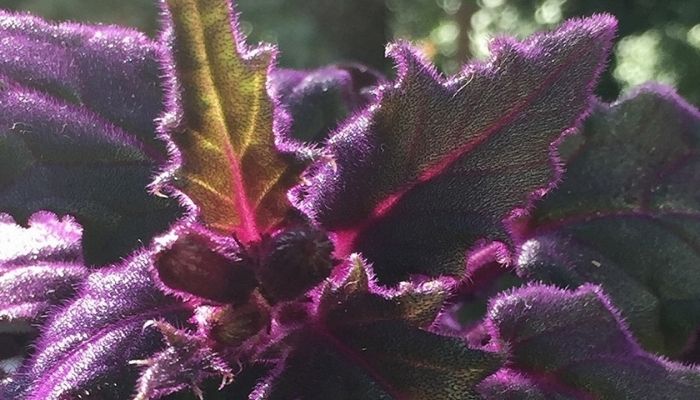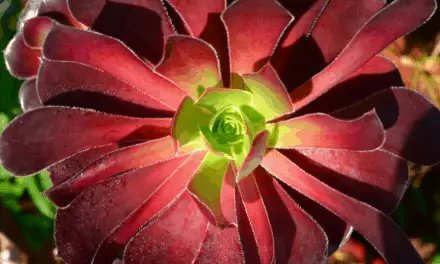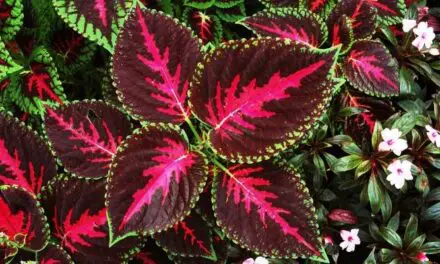Due to their vibrant green leaves and contrasting velvety purple fur, purple passions are a popular houseplant for indoor decoration.
These plants are stunning to look at but they are also quick to show you when they are not feeling well.
Table of Contents
Why Does My Purple Passion Plant Have White Spots?

Your purple passion plant has white spots because it either has a fungal infection or a mealybug, whitefly, or scale infestation.
Let’s look a little closer at each of these common causes of white spots and try to determine how serious it is for your plant and what you can do to treat it.
Powdery mildew
Powdery mildew is often the culprit of white spots on your purple passion plant.
It is a fungal disease that can affect the leaves, stems, and flowers of your plant.
This most often appears on the surface and underside of the leaves as pinhead-sized white spots.
How To Treat It
With clean shears and gloves, cut and throw away all affected parts.
If that doesn’t get rid of it, you may have to apply a fungicide like sulfur, potassium bicarbonate, or neem oil on the affected areas.
It may be a good idea to do it anyway to ensure the fungus doesn’t spread or return.
Also Read: How To Make Aglaonema Bushy (Explained)
How To Prevent Powdery Mildew On Your Purple Passion Plant
To prevent powdery mildew on your purple passion, avoid watering overhead and prune any overcrowded areas to increase airflow.
This will reduce humidity and stop development on the leaves.
Reducing humidity is the key to staving off infection.
Pest Infestations
Pest infestations can also be a leading cause of white spots on your purple passion plant.
Although that velvety fuzz covering your plant offers protection, it can also host a number of insects that can cause white spots.
There are a few different pests that can do this to your purple passion plant.
First, inspect the leaves to see if the white spots move or reproduce.
Also, note the texture and appearance of the spots and the leaves.
Are they sticky, wilting, curling, or discoloring?
Mealybugs
If the white spots are on the foliage, stems, and roots that look like cotton, then your purple passion plant most likely has mealybugs.
The cotton substance comes from the females; it’s used to hide their eggs.
This causes the plant to wilt and drop leaves.
The bugs suck the sap, which results in their excreting honeydew all over the plant.
How To Treat Mealybugs On Your Purple Passion Plant
To remove the Mealybugs, take a cotton swab with at least 70% isopropyl alcohol and touch every mealybug you see.
Then, spray the leaves with insecticidal soap.
If the bugs are on the roots, get a systemic insecticide that has imidacloprid or disulfoton.
Whiteflies
Whiteflies are another insect that causes white spots on your purple passion plant by sucking its sap and producing honeydew deposits on the leaves and stems.
When this happens, the leaves feel dry and turn yellow.
If left untreated, the leaves will fall from the plant.
Both adults and nymphs feed on the plant, but the nymphs will do the most damage.
This is because the nymphs affix themselves to leaf undersides and, for the next four weeks, consume the nutrients of the plant until it matures into an adult.
How To Treat Whiteflies On Your Purple Passion Plant
You want to use a two-pronged insecticide approach to ensure you get both adults and nymphs.
Use an insecticide that has tetramethrin, pyrethrins, resmethrin, or sumithrin to get rid of the adults.
For the nymphs use something like neem oil or insecticidal soap.
Scales
Scales can also appear as white spots on your purple passion plant.
Scales are insects with powerful mouths that attach themselves to the stems and, sometimes, the leaves.
A wax-like substance covers their bodies, giving them a white or beige appearance.
They also feast on the plant’s sap and produce honeydew excrement.
The honeydew, along with the depletion of the plant’s nutrients, will cause the purple passion to wilt, force the foliage to fall off, and eventually die.
The black mold that results from the honeydew weakens the plant by preventing it from performing proper photosynthesis.
How To Treat Scales On Your Purple Passion Plant
To control scales, use an insecticide that has resmethrin or pyrethrins once a week.
Permethrin and bifenthrin insecticides will allow you to control the infestation for a longer period of time.
Final Thoughts
Although purple passion plants are pretty tough and mostly tolerant to diseases and infestations, they can sometimes fall victim to them.
As long as you’re keeping a watchful eye on your plant, you should be able to cure any of these issues before they have a chance to do any permanent damage.




